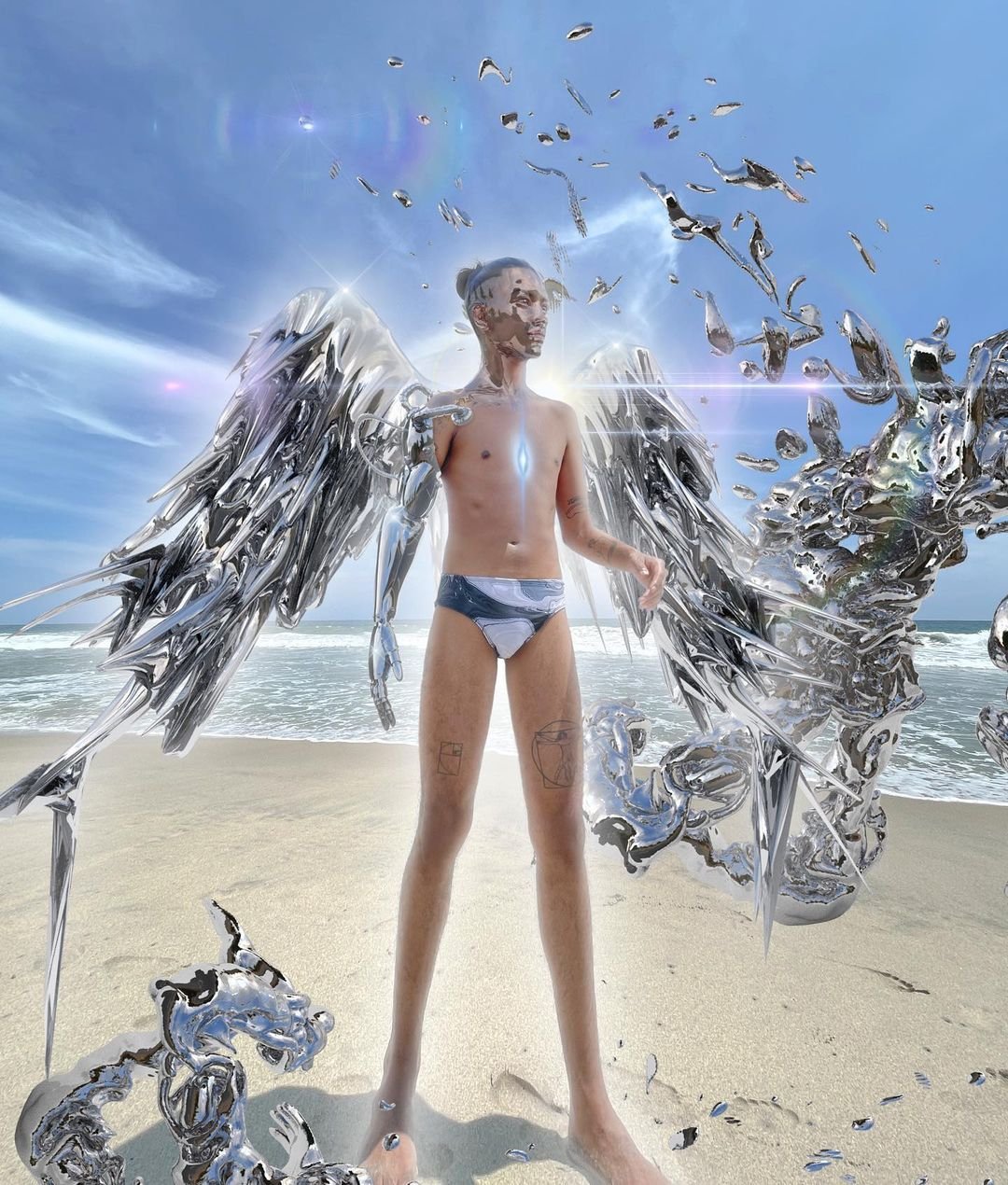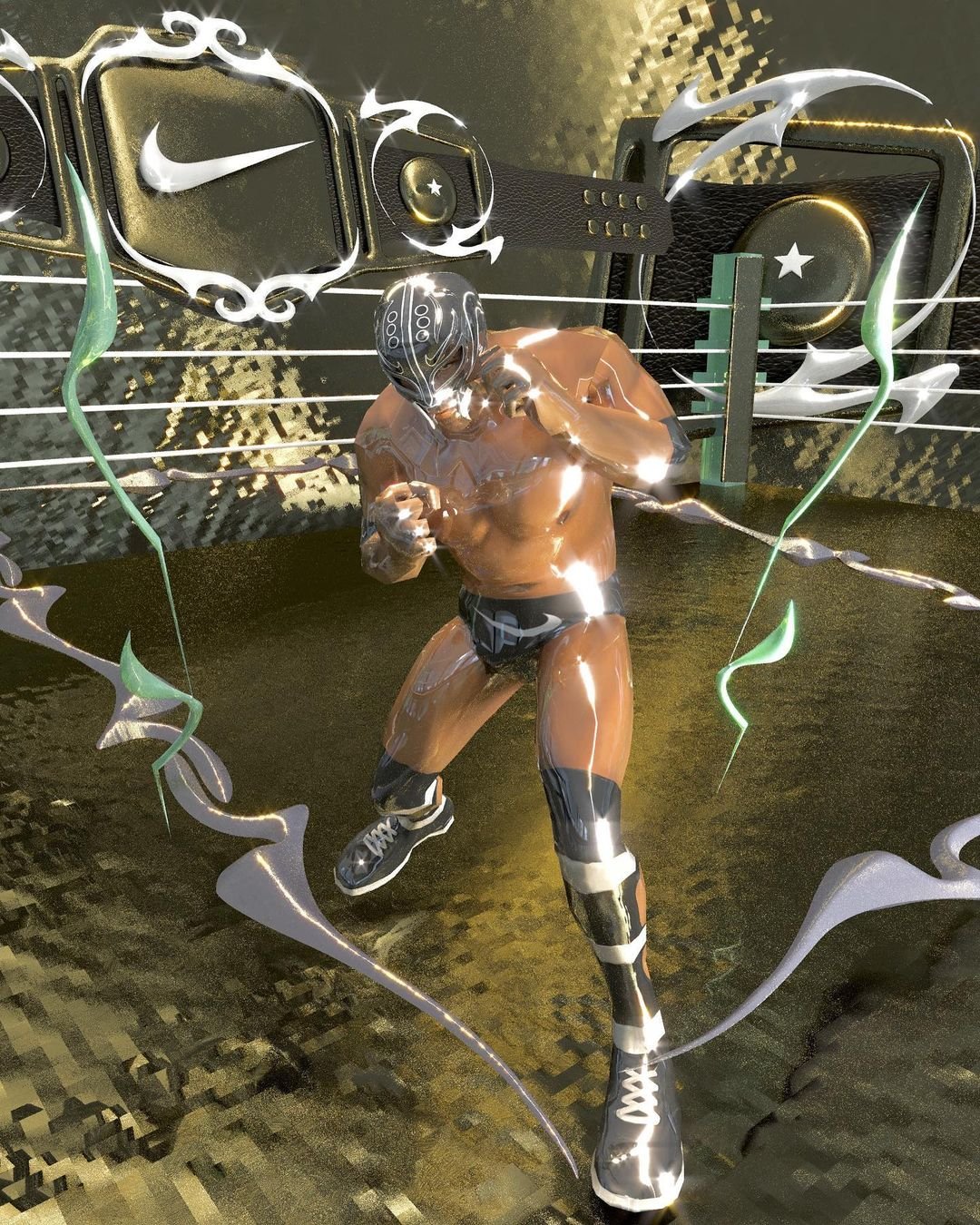Oswaldo Erréve
The LA native NFT artist Oswaldo Erréve blends seamlessly the lines of ground-breaking discipline of digital art with a in-the-cheek chromatic vision; his digital armour concept “Cryptoshield” answers the questions of sustainable ethical fashion without a pinch of resistance for austerity.
This is how to be the baddest b*tch of the metaverse.
I would like to start by asking you about your Fashion Film, ‘’VROCUGEON’’, that’s coming up in just under two weeks, can you explain to me in a bit more detail what this film is about, and what are your feelings about it now towards the end of the execution process?
Vrocugeon feels like the closing of a cycle just because I have been working in this project for months and finally, after a long long research, study and invest of time is being born.
In my work I explore transhumanism - the symbiosis between synthetic and organic elements. I think about Vrocugeon as a hacking meta spiritual human being who in the past was a living organism existing in a natural ecosystem full of plants, but now hasbeen driven into a white VR space with a digital shield that can help him/her to save the planet from global industries (like fashion industry and the ultra fast fashion companies, whose production invades ecosystems causing them a long-term damage).
I name my projects with hybrid non-existent words - Vrocugeon is a hybrid word between ‘ouroboros’ and ‘dungeon’ - which it means to me like being in a kind of weird wormhole gothic videogame, which repeats once and again. Now, at the end of this project I can feel so satisfied because all my learning and knowledge about new technologies are applied here. It has been like manning a mothership through different spaces.
‘’Cryptoshield’’ is an amazing project comprehending the excitement and fantasy fashion has always had, but without the environmental downside of physically produced items, what does fashion expression mean to you?
Art, history, science and technology must be concepts which can coexist in a unique word: Fashion. Science and technology give us the opportunity to respond with alternatives on the consumption of garments that are eco-friendly. Talking about this entire AR world where you can be whoever you want and you can wear whatever you want wherever you are or talking about textile recycling and upcycling and implement new different materials to produce a long-term garment.
I imagine a future where when you are born you are asigned to wear a unique piece which is going to be adaptable to your size as you grow up, and this piece will never wear out. AR developers and fashion designers could find a new spectrum of marketing, it could be possible to be launched a kind of ‘smart watch’ that when you use it, it has the possibility to make a holographic projection of a digital wearable on you.
In the cultural and humanistic side, art and history can help us to learn about ourselves’ expression and learn to be responsibles about consumerism. I became more sensitive - I was reading this article about ultra fast fashion illustrated with photographies by Martin Bernetti of Atacama desert and the mountain of unsold clothing from fast-fashion retailers. I start with this designing something that is not going to cause any damage to earth, it could be ahead of time right now but in the future could save lifes. What I can do for my planet in the present is not to support consumerism. I’m always into two options: 1. When I have to invert money in buying clothing I do it thinking of the life time of my garment. 2. Recycling my own clothes and producing hybrid garments.
Expanding on that idea, how do you feel the fashion industry can build realities outside of wastage and mindless consumption, while still creating art and its surrounding communities?
Fashion industry is like a solid bone structure which never will be turned into ashes. I don’t know if it has the possibility to change so quickly since for many years it has being more and more solid. I acknowledge the efforts for inclusion on race and gender that fashion industry has been driven in the last years, but it’s also important to fight for the rights of the world where these people live in.
How did your collaboration with the LACMA museum come about, and how did you feel when approaching traditional institutions about NFT / digitally rendered art?
I got the Art + Technology Lab grant by LACMA thanks to my collaborators here in Mexico City. We have presented a proposal to apply for this grant and they found it interesting the project speech.
MUXX (@muxxproject) is the name of the project we are working on. It explores non-binary identity through the lense of the Muxe (a third gender identity from Zapotec people in the Istmo de Tehuantepec in Oaxaca) and its connection to multimedia tools and new technologies. It speaks for social justice and change, celebrates and gives platform to indigenous POC voices, queer voices and latinx voices, all in the context of a major american cultural insitution.
I feel very excited to work with all the tech knowledge I’ve been learning and making it possible through this level of institution is an incomparable pleasure, not only for showing my work but also (and the most important) for showing part of the indigeouns cultural heritage of my country.
I have been able to see that you are Hispanic (I am as well), and as someone who has experienced this first hand, how do you feel like Hispanic/Latinx narratives are silenced and do you feel like indigenous-futurism / Latinx superstructures can be brought into more conversations thanks to digital metaverses?
As Latinxs we are reigning the spaces in which we need visibility. Not only for being a silenced community just like black people, LGBTQ+ people or indigenous communities. I would say that we are no longer in the position of being oppressed, we have been fighting to arise our voices for years and sometimes we are finding it difficult but we are achieving it by leaps and bounds.
Although my work is not political, currently everything in social networks and all the internet is constructed on base of socio-political statements. I am raising my own voice with the tools that I have at my fingertips for me and for my closest communities.
I totally think that we as a reduced community being queer people or indigeouns people, we are having the visibility we have always deserved (late but we stand here like warriors). As a metaphore, I perceive my project CRYPTOSHIELD / VROCUGEON as a representation of the fight that me and my community are developing currently with all the industries driven by patriarchy and heteronormativity. We are clearly seeing the places we can reach and the connections we can have in the physical world or in the metaverse.
And to finish off, as a digital artist I imagine you must spend a considerable deal of time thinking about how these new emerging worlds are going to look like in the mid to long-term future, specially with the new ‘’Meta’’ concept by what was Facebook, is there a positive feeling to feel like a certain future is approaching or do you in a way feel like a space that you took part of is now being, in a way ‘’occupied’’?
As a multimedia expressor of ideas (‘artist’), I think about the future when I am developing an idea or when I am producing this idea. When a concept comes to my head I think about it as a possibility for the future. It’s like in this project - I thought of a shield that you could wear and it can give you protection in a utopian or dystopian future to fight for your own planet, and do it being a stylish b*tch, lol.
But I really don’t spend time thinking of what future will be like. Sometimes I imagine some scenarios but more than that I like to be surprised by the advance of technology and the capability that I have to use it for my own benefit, speaking about knowledge and work.
interview SOL RUIZ BASTIDA
What to read next


























